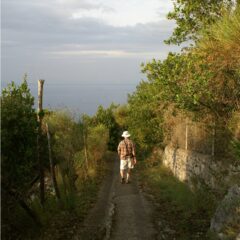Our little group just finished another hike to Mount LeConte near Gatlinburg, Tennessee, USA. I’ll post all the details later, but I wanted to share a part of the trip with you in a condensed version. We were at the top of Mt. LeConte for two nights spending the entire day there on April 27. As usual the weather was changeable. We had hiked up in a thunderstorm on the 26th and had intermittent clouds and sunshine most of the 27th.

As you can see above the day started off with clouds. It was somewhat humid, but the temperature by afternoon was in the mid 50’s Fahrenheit. Our intention was to spend the day hiking around the top of Mount LeConte and taking it easy. We had come up Alum trail again which is a fairly strenuous trek, particularly in the rain of a thunderstorm. We wanted to go over the top of the mountain to Myrtle Point, which affords the best views of sunrise on Mount LeConte, to spend an hour or two in the afternoon resting on the rocky ledge looking out over the Great Smoky Mountain National Park. As we pushed along we soon saw an unmistakable image of why these mountains are called the Smokies.

Looking at the above picture, the view is along a ridge that runs south from Mount LeConte. The Boulevard trail follows this ridge from LeConte to the Appalachian Trail. The wind is from the west, or moving from right to left in the picture. As the wind rises up from rises up from the valley to the crest of the ridge there are no clouds to the west, but as soon as the wind crosses the ridge, clouds boil up from the east side like smoke from a volcano, creating a vision of smoke rising out of the ground. After a couple of hours it diminished, but it was an amazing sight while it lasted.

On Myrtle Point, even with the Smokies haze, the view is what you go to the mountains for. Although, you might see something similar from a car, there is nothing like getting to the top of a 6000 foot mountain on your own feet and taking your shoes off while resting in the sun and the clouds. Yes, sometimes you are in the clouds. Myrtle Point juts out into space and is a granite point surrounded by low growing Myrtle shrubs. It is accessible only by walking at least six and a half miles up and over Mount LeConte or by hiking over seven miles from Newfound Gap along the Appalachian and Boulevard trails. Thus, the view above is not a sight everyone will see with their own eyes. You should try though, because it is incredibly peaceful and restful, to sit there and look out at the mountains and the ever-changing sky.
Near the crest of Mount LeConte, along the Boulevard trail, there is an Appalachian Trail through hiker shelter that gives the through hikers a respite if they decide to take Boulevard to LeConte and then venture down into Gatlinburg. Since our last visit to LeConte about 6 months ago, the National Park Service installed a new composting toilet for the use of the through hikers. It seems to work well, but like every thing else I’ve been talking about. It’s up hill to get there. In fact, at the bottom of the Alum Cave trail the National Park Service erected this sign which has warnings to hikers to take precautions

because of the footing. The sign states, in part: “This trail is steep and rocky. Wear sturdy boots with adequate ankle support.” Further, if you look closely, you will see that the sign also indicates that the summit is over five miles away, at over 6,500 feet and takes four of five hours of hiking to reach.

The part of the trail shown above is in the lower half of the trail. As I stated earlier, the new composting toilet at the through hikers shelter is near the summit of Mount LeConte and there is no way to get there, except on the trails. So, take a look at what the National Park Service installed for the through hikers to use.

They have their very own Americans with Disabilities Act approved toilet. I have carried a back pack up or down every trail leading to this toilet on all sides of Mount LeConte. I guarantee you that any person who required such a toilet as part of his/her normal life would not be able to roll their wheel chair to this toilet, even if you carried them to a spot within a quarter of a mile from the toilet. At Goneguru, we want everyone to have a quality life and to enjoy travel and the great outdoors. We support research for such disabling diseases as Multiple Sclerosis, but some things just don’t make sense. If you can explain to me the logic in why this toilet was configured to be ADA approved, please do so.

